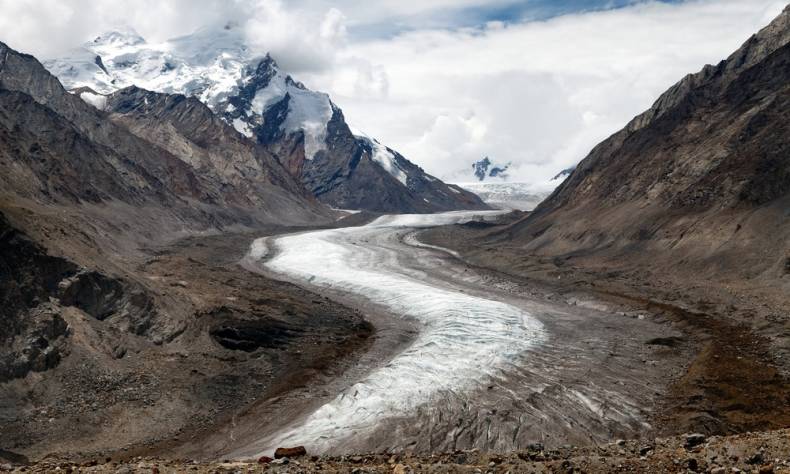
The Tibetan Plateau: So Fresh, So Clean, So Fragile
On November 18, the Institute of Tibetan Plateau Research of the Chinese Academy of Sciences (CAS) released a report on how clean the air is in up on the plateau, comparing the region favorably to areas such as the Arctic and the French Alps. The report then goes on to say that the level of pollutants atop the plateau is “remarkably lower than that of densely-populated areas.” This was reported widely as though it was some groundbreaking fact, although it seems pretty obvious that a region with 2.56 people per square kilometer might be less polluted than a mega city of 1,300 people per square kilometer (Beijing).
The report continued by saying that black carbon – fine particulate matter that is a climate forcing agent – has increased to the highest level it has been in 100 years, which is more than likely that it is the highest it has been ever. The report then blamed the increase in black carbon on the plateau on South Asia and Central Asia, yet this claim appears to be backed up to some degree – Chinese emissions obviously still play a part – by a 2009 animation from the NASA/Goddard Space Flight Center Scientific Visualization Studio that shows black carbon (otherwise known as soot) density and its movement over a three-month period.
Despite the video being from 2009 and soot density perhaps changing incrementally since, the wind patterns remain the same: from northern India up, the winds blow west; closer to the Equator, they blow east. That would suggest that China’s pollution gets blow eastward and across the Pacific by the westerly winds, while northern India’s get blown east to China.
So, the report established that the air is clean atop the plateau, but what did not get a lot of press on the report’s release was the effect climate change is having on the region’s glaciers.
Glacial retreat is an issue all over the world, so it is not as though this is a China-only issue, but the Himalayas – sometimes referred to as “the water towers of Asia” – are the beginnings of some of the world’s most important waterways: the Yangtze and Yellow rivers in China, the Bhramaputra in India and Bangladesh, and the Mekong and Salween rivers in Southeast Asia.
In 2011, Cheng Haining, a senior engineer with the provincial surveying and mapping bureau in Qinghai Province, told Xinhua that 5.3 percent of the glaciers in the Yangtze headwaters had melted. Sound bad? Not compared to the glaciers that feed the headwaters of the Mekong – known in China as the Lancang River – of which 70 percent have melted, according to Cheng.
Then in 2014 a study from the Chinese Academy of Sciences revealed that China had lost 18 percent of its western glaciers (in Chinese, coverage here in English by the WSJ) since 1950. What is happening is that these glaciers melt and the waters flow down, as all water does, but it is flowing down in greater volumes and with greater force than in years prior. While some academics have suggested that this will be good for agriculture in the short-term, as more water almost always is, it is also likely that this will mean increased flooding and landslides, as well as water shortages once the glaciers melt fully.
Again, this is not meant to blame China for the warming of a plateau and melting of glaciers that just happen to be within its borders. We, the collective “we” of nations, have warmed the world, and we need to realize the possible repercussions before it is too late. From the melting of glaciers releasing increased volumes of water to the melting of the plateau’s permafrost releasing carbon into the atmosphere to the critical role that the plateau plays in temperatures and climates as far away as Europe, the region is an all-important biome that is fragile and should be developed with caution.
But despite the need for sustainability, China has big plans for the rivers of Tibet, harnessing hydropower to feed the country’s eastern, more developed provinces and cities. These dams have not been without controversy, with some in India and Bangladesh worried at how the projects – the Zangmu Dam on the Brahmapurta was completed in October and a host of projects are planned for both the Brahmaputra and the Salween rivers – will affect the ecosystems downriver, although that has not stopped India from engaging in equally ambitious and similarly controversial hydropower projects.
Look, hydropower is better for the global environment than the burning of coal, and no one should suggest that China, or India for that matter, do away with such a move towards more sustainable energy generation. But hydropower is not without its own downsides, namely the flow of water affecting those downriver, the fish stocks that provide a lifeline to so many regardless of nationality, and the dispersion of river silt. As such, China has a responsibility to much of Asia and the world to care for the Tibetan Plateau and its rivers in a sustainable manner.
 Facebook
Facebook
 Twitter
Twitter
 Linkedin
Linkedin
 Google +
Google +











miss those days when i was there
I have never been to Tibet. It is a myserious place to explore.
Let’s bring the convo to a higher plateau